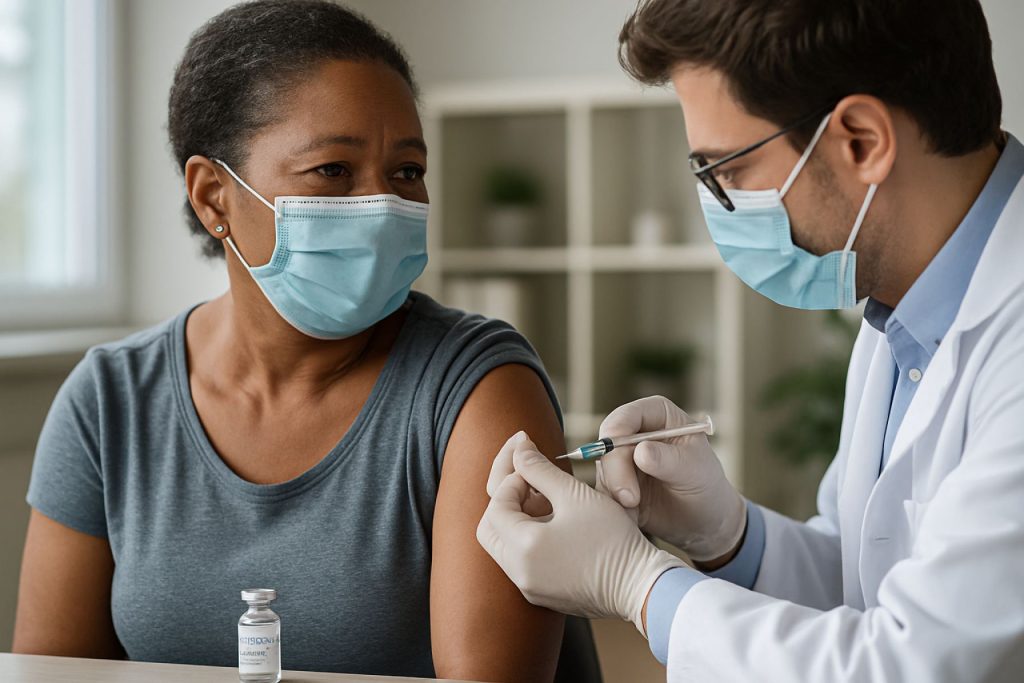
- The FDA is tightening COVID-19 vaccine approvals, prioritizing high-risk groups such as adults over 65 and those with significant health risks.
- Healthy individuals may face barriers to booster access, with over 40% of American adults potentially excluded from updated vaccines.
- New “gold-standard” data requirements for lower-risk people aim to ensure only those who clearly benefit receive boosters.
- Experts warn this shift could raise COVID-19 transmission and reduce protection for vulnerable populations.
- The policy change may also increase vaccine hesitancy and undermine public trust amid declining booster uptake.
- The debate underscores tensions between scientific scrutiny, individual choice, and public health priorities.
A hush—laced with confusion and tension—has settled over America’s vaccine landscape. This week, federal regulators abruptly steered COVID-19 vaccine policy in an unexpected direction, one that could leave tens of millions questioning both their access and the agency’s motives.
What’s changed? For the first time since the pandemic began, the Food and Drug Administration (FDA) has announced it will tighten its scrutiny on COVID-19 vaccine approvals. This is no minor adjustment: regulators are now prioritizing those considered at highest risk—for instance, adults over 65 or anyone older than six months with significant risk factors—while placing fresh barriers between healthy individuals and the next round of booster shots. Those hoping for easy, across-the-board access may soon find the pink slip at the pharmacy.
The echoes of this decision reach far. With over 40% of American adults not meeting the new risk criteria, vast swaths of the population may lose the option to receive updated vaccines—even as new SARS-CoV-2 variants continue to roll ashore.
Why this sudden pivot? The FDA argues that its “gold-standard” data requirements for healthy, lower-risk individuals are necessary for clear-eyed, evidence-based approvals. The agency cites uncertainties: Would another dose benefit a healthy middle-aged adult who’s been vaccinated, had COVID multiple times, and remains symptom-free? The underlying message: Prove benefit, or don’t offer the vaccine.
Yet, experts warn the move could ricochet through communities. Immunologists stress that boosters still cut the risk of illness—even mild cases—and help to shorten and soften symptoms. And as the CDC reminds, vaccination reduces the odds of “long COVID,” an often-devastating shadow illness characterized by months of fatigue, brain fog, and more.
Vivid concern pulses among public health leaders. Many fear millions of Americans will now find themselves unable to protect vulnerable family members—grandparents, the immunocompromised, or unvaccinated infants—by limiting possible transmission. Others warn that the shift may further undermine confidence, fueling vaccine hesitancy at a precarious moment: U.S. booster uptake has already dipped below 25% annually.
Meanwhile, the larger political story hovers overhead. Senior vaccine regulators have been ousted from federal health agencies. Misinformation and internal disputes crackle through the headlines. And behind it all, trust—always hard-won and easily lost—hangs in the balance.
As the dust settles, one fact remains clear: Vaccines, even for those at lower risk, have played a critical role in containing the pandemic’s more dangerous chapters. While the FDA’s new approach is rooted in scientific scrutiny, it also hands the public a stark new reality—one in which the freedom to choose protection is no longer guaranteed.
Key takeaway: The FDA’s major recalibration of COVID vaccine policy could limit access for millions, spotlighting an urgent debate about public health, individual choice, and the true cost of caution in a changing world.
Millions Left Behind? What You Must Know About the FDA’s COVID Vaccine Access Change
The New FDA COVID Vaccine Policy: What Changed & Why It Matters
The FDA’s sudden tightening of COVID-19 vaccine access isn’t just a technical shift—it sends shockwaves through public health, personal freedoms, and trust in medical systems. While the original article covered the immediate policy change, here are expanded facts, actionable advice, and pressing questions answered based on up-to-date data and deeper expert insights.
—
Deeper Dive: What Is the FDA Doing Differently?
– Targeted Boosters Only: The FDA now prioritizes updated boosters for adults over 65 or anyone over six months with major risk factors (immunocompromised, chronic conditions, etc.).
– Stronger Data Required for Healthy People: For healthy, younger populations, further boosters are withheld unless manufacturers provide more rigorous, targeted clinical trial data demonstrating significant benefit.
– Historic Pivot: This is the first substantial restriction on vaccine access since early pandemic days, contrasting with earlier wide-ranging approval.
—
Additional Facts the Article Missed
1. International Comparison
– The European Medicines Agency (EMA) and the UK’s MHRA still recommend annual boosters for more adults, not just high-risk groups (source: [World Health Organization](https://www.who.int/)).
– Several countries have been broadening access before the U.S. pivot.
2. Waning Immunity Real-World Trends
– Recent studies (Lancet, NEJM) confirm protection from infection starts to wane after 4-6 months but remains strong against severe illness and death, especially for older populations.
– Mild or asymptomatic cases in healthy people often recover rapidly but can sometimes result in “long COVID” (CDC data estimates 1 in 13 U.S. adults experience long COVID symptoms).
3. Long COVID Risks
– New research suggests even mild infection can trigger long COVID in 10-20% of cases, with women and middle-aged adults at higher risk (source: [NIH](https://nih.gov)).
– Vaccination prior to infection significantly reduces the risk and severity of long COVID (CDC guidance).
4. Demand and Supply Insights
– Pharmacies and clinics report surplus vaccine stock due to lower demand; some may discard expired doses, raising supply chain sustainability concerns (Kaiser Health News).
5. Societal Ripple Effects
– Workplaces and schools may struggle to set clear return-to-work/school protocols due to varied vaccine access.
– Health insurance providers are actively reviewing coverage for off-label vaccine access; costs may shift to consumers in some cases.
—
Q&A: Pressing Reader Questions
Q: Can I still get a booster if I’m not in a high-risk group?
A: As of the new rules, healthy adults under 65 or kids without risk factors are generally not eligible. Some providers may offer off-label administration, but insurance may not cover it.
Q: Is it safe to mix and match vaccines if I find one privately?
A: Studies show mixing mRNA vaccines (Pfizer/Moderna) is safe and often increases immunity; consult your doctor for personal recommendations (CDC).
Q: Should I worry about missing a booster?
A: Protection from previous doses, especially against severe disease, remains for most people. However, discuss your personal risk (jobs, family exposure, travel) with a health professional.
Q: Does this mean the pandemic is over?
A: No. The move reflects a shift to treating COVID-19 as a manageable, endemic disease for most—but the virus continues to mutate and cause disruption.
—
Booster Access: How To Decide If You’re At “High Risk”
1. Age 65 or older: Automatically eligible in the new system.
2. Underlying health conditions: Asthma, diabetes, obesity, cancer, autoimmune or chronic lung/heart/kidney disease. Ask your provider if you qualify.
3. Immunocompromised: Transplant recipients, chemotherapy patients, HIV with low CD4, etc.
4. Are you a caregiver or live with high-risk individuals? While not strictly qualifying, some clinicians may still try to prioritize you.
—
Pros & Cons of the FDA’s Policy Change
Pros:
– Focuses limited clinical resources on those who benefit most.
– Reduces potential over-vaccination and rare adverse reactions in the healthy.
– May accelerate targeted vaccine research for new variants.
Cons:
– Leaves millions without easy vaccine access—even if they want protection.
– Risks undermining public trust and fueling confusion or hesitancy.
– Potential for increased mild/moderate illness and transmission.
– Could worsen health inequities among marginalized or uninsured groups.
—
Controversies & Industry Reaction
– Vaccine Manufacturers are frustrated. Pfizer and Moderna urge broader access, citing safety and benefit data.
– Immunologists warn the move is “overly cautious” and leaves gaps in herd immunity.
– Public Health Officials are split: Some say society must adapt; others push for choice.
– Activists & Patient Groups decry the “one-size-fits-all” approach as dangerous for complex, multi-generational households.
—
Market & Policy Outlook
– Market Trend: Expect a drop in demand for COVID-19 boosters in the U.S. but possible switch to high-margin, targeted vaccines—especially for seniors (Wall Street Journal).
– Policy Prediction: If new, more severe variants circulate, the FDA may again broaden access. Monitor CDC and WHO updates regularly.
—
Security, Safety, & Sustainability
– Vaccine Safety: U.S. mRNA vaccines retain excellent safety profiles. Mild side effects are common; severe events are extremely rare (CDC Vaccine Adverse Event Reporting System).
– Sustainability: With restricted access and excess stock, expect companies to reconsider production volumes or donate surplus abroad.
—
Quick Tips & Actionable Recommendations
– Check Your Eligibility: Use the CDC’s vaccine eligibility checker or speak with your doctor.
– Document Risk Factors: Keep records of diagnoses or medications to streamline vaccine access.
– Stay Up-to-Date: Monitor both [CDC](https://cdc.gov) and [FDA](https://www.fda.gov) for guideline updates.
– Consider Other Protections: Masks, home antigen tests, and ventilation remain key tools.
– Advocate: Urge policymakers to include flexibility for households with high-risk individuals or unique needs.
—
Related Links for Further Reading
– Centers for Disease Control and Prevention
– National Institutes of Health
– Food and Drug Administration
– World Health Organization
– Kaiser Family Foundation
—
Final Takeaway
The FDA’s recalibration marks a dramatic shift in America’s pandemic response—from universal protection to focused, evidence-driven access. While the goal is sound science and individualized benefit, the result may be more confusion, uncertainty, and division about who is allowed to defend themselves against COVID-19. Stay informed, know your risk, and speak up for the right to choose your health protections.
—
Quick Action:
Check your vaccine status and eligibility on the CDC website today. Don’t assume you’re covered—explore your options, especially if you or loved ones are at risk. Stay vigilant as policies and variants evolve.



